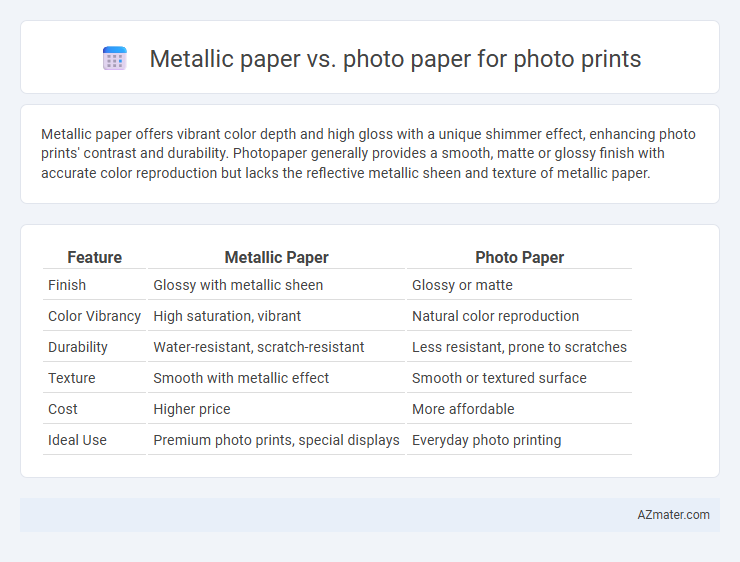Metallic paper offers vibrant color depth and high gloss with a unique shimmer effect, enhancing photo prints' contrast and durability. Photopaper generally provides a smooth, matte or glossy finish with accurate color reproduction but lacks the reflective metallic sheen and texture of metallic paper.
Table of Comparison
| Feature | Metallic Paper | Photo Paper |
|---|---|---|
| Finish | Glossy with metallic sheen | Glossy or matte |
| Color Vibrancy | High saturation, vibrant | Natural color reproduction |
| Durability | Water-resistant, scratch-resistant | Less resistant, prone to scratches |
| Texture | Smooth with metallic effect | Smooth or textured surface |
| Cost | Higher price | More affordable |
| Ideal Use | Premium photo prints, special displays | Everyday photo printing |
Introduction: Metallic Paper vs Photo Paper
Metallic paper offers a unique glossy finish with a shimmering effect that enhances color vibrancy and depth, making it ideal for high-impact photo prints. Photo paper, available in matte or glossy finishes, provides a more traditional look with smooth textures that suit everyday photographic prints and professional portraits. Choosing between metallic paper and photo paper depends on the desired visual impact, durability, and the printing technique used.
What is Metallic Photo Paper?
Metallic photo paper features a pearlescent finish that enhances color depth and contrast, providing a vibrant, glossy look ideal for high-definition photo prints. Unlike traditional photopaper, metallic paper contains a unique reflective layer that gives images a luminous, three-dimensional effect, making colors pop with increased saturation and sharpness. This specialized paper is favored for professional photo prints, offering durability and a premium aesthetic suitable for portraits, landscapes, and fine art photography.
What is Traditional Photo Paper?
Traditional photo paper is a type of paper coated with light-sensitive chemicals that capture and preserve photographic images with high fidelity and color accuracy. It typically features a glossy or matte finish, designed to enhance image sharpness and vibrancy, making it ideal for everyday photo printing. Unlike metallic paper, traditional photo paper provides a classic look and texture without the reflective, lustrous sheen characteristic of metallic prints.
Visual Differences: Shine and Color Depth
Metallic paper offers a unique shine that enhances contrast and gives prints a vibrant, reflective finish, intensifying color depth for a dynamic visual impact. Photopaper typically provides a smooth, glossy surface with accurate color reproduction but lacks the reflective metallic sheen, resulting in softer highlights. The choice between metallic paper and photopaper directly affects the visual outcome, with metallic paper emphasizing bold contrast and a luminous effect, while photopaper prioritizes subtle color accuracy and smooth texture.
Durability and Longevity Comparison
Metallic paper offers superior durability due to its scratch-resistant coating and resistance to fading, making it ideal for long-term photo displays. Photopaper, while providing vibrant color reproduction, is generally more susceptible to fading and damage from moisture and UV exposure over time. Choosing metallic paper enhances photo longevity significantly, especially in environments with high exposure to light and handling.
Print Quality and Detail Reproduction
Metallic paper offers vibrant colors and high contrast with a glossy or semi-gloss finish that enhances print quality, making photos appear sharper and more dynamic. Photopaper, designed specifically for photo printing, provides excellent detail reproduction with smooth gradients and natural color tones, ideal for intricate images. Both surfaces impact print outcomes, but metallic paper excels in vividness and depth, while photopaper maintains finer detail and subtle textures.
Ideal Use Cases for Metallic Paper
Metallic paper excels in producing vibrant, high-contrast photographic prints with a glossy finish, making it ideal for professional portraits, product photography, and fine art prints that benefit from enhanced color depth and a reflective sheen. Its durable surface resists fingerprints and fading, ensuring longevity in displays and galleries. This paper type is preferred for creating impactful images that require a striking, premium appearance.
Ideal Use Cases for Photo Paper
Metallic paper offers vibrant colors and high contrast, making it ideal for portraits, landscapes, and images requiring a glossy, eye-catching finish. Photopaper, available in various finishes like matte, glossy, and satin, provides versatility suitable for everyday printing, professional photo albums, and gallery-quality prints. Choosing between metallic paper and photopaper depends on the desired aesthetic, durability, and specific use case such as exhibition prints or casual photo sharing.
Cost Comparison: Metallic vs Photo Paper
Metallic paper typically costs 20-30% more than standard photo paper due to its aluminum-coated surface that enhances color vibrancy and durability. Photo paper prices vary widely, ranging from budget-friendly options at around $0.10 per sheet to premium glossy papers up to $1.00 per sheet, while metallic paper sheets often start at $0.50 and can exceed $1.50 depending on size and brand. For high-volume printing, standard photo paper remains more economical, but metallic paper offers superior image quality and a longer lifespan, which may justify the higher expense for special projects or professional prints.
Choosing the Best Paper for Your Photo Prints
Metallic paper offers vibrant colors, high contrast, and a glossy, reflective finish that enhances depth, making it ideal for dynamic and striking photo prints. Photopaper, available in matte or glossy finishes, provides versatile options with smooth texture and accurate color reproduction, suitable for everyday prints and detailed images. When choosing the best paper for your photo prints, consider the desired visual impact, durability, and the printer's compatibility to ensure optimal results tailored to your specific project.

Infographic: Metallic paper vs Photopaper for Photo print
 azmater.com
azmater.com